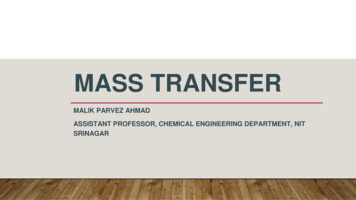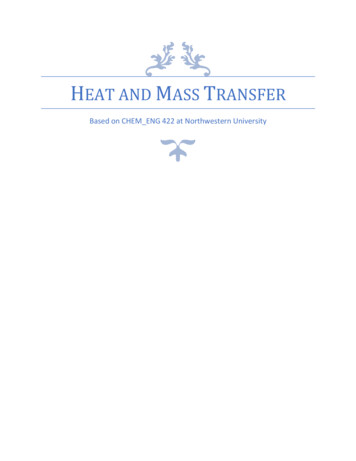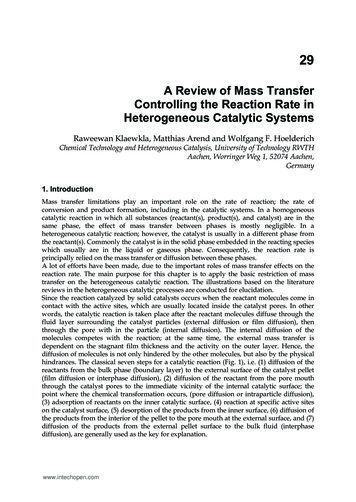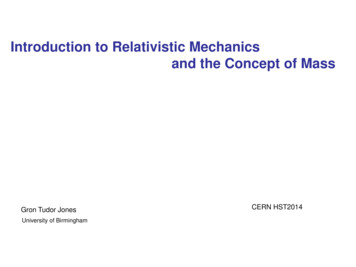
Transcription
MASS TRANSFERMALIK PARVEZ AHMADASSISTANT PROFESSOR, CHEMICAL ENGINEERING DEPARTMENT, NITSRINAGAR
TOPICS: INTRODUCTION TO MASS TRANSFER SEPARATION PROCESS MOLECULAR DIFFUSION INTERPHASE MASS TRANSFER MASS TRANSFER COEEFICEIENTS GAS ABSORPTION GAS LIQUID CONTACTING EQUIPMENTS DISTILLATION DRYING CRYSTALLISATION
INTRODUCTION OF MASS TRANSFER Mass transfer may occur in a gas mixture, a liquid solution or solid. Mass transfer occurs whenever there is a gradient in the concentration of a speciesDriving Force The basic mechanisms are the same whether the phase is a gas, liquid, or solid. The transfer of mass within a fluid mixture or across a phase boundary is a process that plays amajor role in many industrial process.
MASS TRANSFER IN NATURE Aquatic life uses dissolved oxygen for survival and supply of oxygen comes from air Absorption of O2 into the blood stream occurs in the lungs of animals andremoval of CO2 from the animal cells into the blood stream Hydrolyzed food materials get absorbed in the intestines Process of doping the junctions of a semi-conductor Dispersion of a pollutant discharged at a point in flowing water
SEPARATION PROCESS
INTRODUCTION TO SEPARATION PROCESS Separation of mixtures constitutes major class of operations in CPI and allied industries The separation process involved are based on the principles of mass transferand are called mass transfer operations Typical Examples Of Separation process: Separation of ammonia from mixture of ammonia and air by waterSeparation of organic vapor from mixture of gases by adsorptionSeparation of CO2 from flue gasCO2 captureSeparation of mixture on the basis of volatility by Heat input
Separation processConcentration DrivenExample: DiffusionAbsorption etc.MechanicalExample: Filtration,Centrifugation, Settling etc.
CLASSIFICATION OF MASS TRANSFEROPERATIONS Direct Contact of two Immiscible phases Gas-GasAll gases are soluble in each other. Notpractically realizable Gas-Liquid Liquid-SoildIncludes Distillation, Gas absorption, StrippingLeac hing
Miscible phases separated by Membranes: Gas-gas Gas-Liquid Liquid-liquid General Examples: Electrodialysis Osmosis Reverse Osmosis
Separation ProcessSeparation agentTypical ApplicationsGas Absorption & StrippingSolventRemoval of CO2 from synthesisgas and CO2 and H2S fromnatural gas.DistillationHeatFractionation of crude oil.Liquid-Liquid ExtractionSolventRemoval of aromatics fromgasoline.Solid- Liquid ExtractionSolventExtraction of caffein fromcoffee.DryingHeat/Drying gasDrying of fruits and polymerbeads.AdsorptionAdsorbent SolidSeparation of organics from gas.Ion ExchangeIon Exchange ResinSeparation of salts.CrystallizationHeat (Removal)Production of salts and sugar.Membrane separationMembraneDesalination of water.
DIFFUSIONUNDERSTANDING BY EXAMPLES A drop of ink released in water gradually spreads to make the water uniformly colored Fragrance of bunch of roses and perfume reaches out to a person Dissolution of sugar in water
MOLECULAR DIFFUSION Def: Molecular diffusion or molecular transport can be defined as thetransfer or movement of individual molecules through a fluid by mean of therandom, individual movements of the molecules. The phenomenon leads ultimately to uniform concentration The two modes of mass transfer:- Molecular diffusion- Convective mass transfer
FICK’S LAW OF DIFFUSION Fick’s LawJAZ*dxA* cDABdzJ AZ is the molar flux of component A in the2z direction in kg mol A/s.m .DAB is the molecular diffusivity of the molecule A in B in23m /s c is the concentration of A in kg mol/m .z is the distance of diffusion in m
EXAMPLE:Q.A mixture of He and N2 gas is contained in a pipe at 298 K and 1 atm total pressurewhich is constant throughout. At one end of the pipe at point 1 the partial pressurepA1 of He is 0.6 atm and at the other end 0.2 m pA2 0.2 atm. Calculate the flux ofHe at steady state if DAB of the He-N2 mixture is 0.687 x 10A.-42m /s.Since a total pressure P is constant, the c is constant, where c is as follows for a gasaccording to the perfect gas law:
3 Where n is kg mole A plus B, V is volume in m , T is temperature in K, R is 8314.33-333m .Pa/kg mol.K or R is 82.057 x 10 cm . atm/g. mol. K, and c is kg mole A plus B/m . For steady state the flux J*Az in Eq.(6.1-3) is constant. Also DAB for gas is constant.Rearranging Eq. (6.1-3) and integrating. Also, from the perfect gas law, pAV nART, and
This is the final equation to use, which is in a form easily used for gases.54Partial pressures are p A1 0.6 atm 0.6 x 1.01325 x 10 6.04 x 10 Pa and pA2 0.254atm 0.2 x 1.01325 x 10 2.027 x 10 Pa.Then, using SI units,
In a non-uniform solution containing more than two constituents, leads to the useof two fluxes to describe the motion of one constituent: N, the flux relative to a fixed location in space J, the flux of a constituent relative to average molar velocity of all constituents For Binary mixture:
STEADY STATE MOLECULAR DIFFUSION INFLUIDS AT REST AND IN LAMINAR FLOWFor gases,
For diffusion of A in non-diffusing B; For equimolal counter-diffusion:
MASS TRANSFER COEFFICIENTS The Rate of Mass transfer increases dramatically if there is motion in the medium Mass transfer occurring under the influence of motion in a fluid medium iscalled Convective mass transferConvectiveForcedFree
DIFFERENT MASS TRANSFER COEFFICIENTS.
DIMENSIONLESS GROUPS IN MASS TRANSFERANALOGY WITH HEAT TRANSFER
INTERPHASE MASS TRANSFERUNDERSTANDING BY EXAMPLES Absorption of ammonia from Ammonia-Air Mixture by liquid water Absorption of CO2 from flue gas by amine solvents Removal of H2S from natural gas In above examples gas is absorbed at the interface of two phases andgets transported to the bulk of liquid
EQUILIBRIUM BETWEEN PHASES Equilibrium between two phases in contactmeans a state in which there is no nettransfer of solute from one phase to other. At equilibrium the concentrations in twophases aren’t equal but chemical potentialof solute in both phases is same Diffusion of components between phasescontinues till Equilibrium is attained
TWO FILM THEORY Mass transfer from one phase to another involves three steps:1.Solute is transported from bulk of one phase to interface2.Diffusion of solute occurs across the interface3.Transport of solute to bulk of second phase Two phase theory states:Lewis & Whitman Basic concept – the resistance to diffusion can be considered equivalent to that in stagnant filmof a certain thickness Two stagnant film exist on both side of interface Mass transfer through these films occurs by Molecular diffusion No resistance to solute transfer exists across the interface separating the phases Resistances in fluid are the only resistances.
OVERALL MASS TRANSFER COEFFICIENTS We define two overall mass transfercoefficients, as shown below: Resistances to mass transfer areexpressed in terms of Overall and localmass transfer coefficients as;
When m is smallWhen m is very large
GAS ABSORTION & STRIPPING Gas absorption is a mass transfer operation in which one or more species isremoved from a gaseous stream by dissolution in a liquid [Solvent] The insoluble component(s) present in the gas which is not absorbed is calledCarrier gas Examples: Removal of H2S from natural gas The reverse of absorption is stripping or desorption
SELECTING A SOLVENT FOR ABSORPTION SolubilitySelective solubility for the solute VolatilityLess volatile solvent is preferred Viscocity Corrosiveness Cost Hazard & ToxicityLow viscosityLess corrosive solventLow cost solventNon hazardous and non-toxic
GAS-LIQUID CONTACTINGEQUIPMENTS
TRAY TOWERS Vertical cylinders in which the liquid and gas are contacted in stepwise fashion ontrays or plates. To provide good contact between the up flowing vapor and the down flowing liquidinside an industrial fractionating column. Liquid enters-top and gas-from downwards through the opening Each tray – act as a stage The tray fluid are brought into intimate contact Interphase diffusion occurs Fluids are separated.
CHARACTERISTICS OF TRAY TOWER Shell and traysTray spacingTower diameterDownspouts / downcomerWeirs
SHELL AND TRAY Can be made of any number of materials. Glass, Glass-lined metal, impervious carbon,plastic, even wood can be used. But most frequently metals are used. For metal towers the shells are usually cylindrical forreason of cost. For cleaning, small-diameter tower are fitted with hand holes. Large towers with manholes about every tenth tray.
TRAY SPACING It is usually chosen on the basis of : expediency in construction maintenancecostFor special cases where tower height is an importantconsideration spacing of 15 cm has been used.
PROBLEMS ASSOCIATED WITH TRAYTOWERS Entrainment High pressure drops Priming Flooding Weeping/Dumping Foaming Coning
PACKED TOWERS
A common apparatus used in gas absorption is the packed tower as shown inprevious Figure The device consist of:a) cylindrical column or towerb) gas inlet and distributing space at the bottomc) liquid inlet and distributor at the topd) gas & liquid outlets at the top & bottom, respectivelye) tower packing – supported mass of inert solid shapes
PACKINGS The packing- provides a large area ofcontact between theliquid and gas- encourageintimatescontactbetween the phases Common dumpedpackings are shown in thefigure:
CALCULATION OF TOWER HEIGHT The equation for packed height (hT) can be written as follows:NTG
For Dilute Gases
DRYINGUNDERSTANDING BY EXAMPLES Wood, cloth, paper etc. can be dried by evaporation of the moistureinto a gas stream. A solution can be dried by spraying it’s fine droplets into a hot,dry gas which results in the evaporation of the liquid. A liquid such as Benzene can be dried of any small watercontent by distillation but removal of small amount of acetoneby same process would not usually be called drying.
PHYSICAL MECHANISM OF DRYING The removal of moisture from a substance is termed as drying Drying is governed by principle of transport of heat and mass First the surface moisture vaporizes, as soon as surface moisture is exhausted moremoisture is transported from inside the solid to its surface Broadly three transport resistances play important roles in drying: Resistance inside the solid to the liquid Convective heat transfer resistance at surface Convective mass transfer resistance at surface
DRYING EQUILIBRIUM Moisture contained in a wet solid or liquid solution exerts a vapor pressure to anextent depending upon the nature of moisture, nature of solid and temperature If a wet solid is exposed to a continuous supply of fresh gas containing a fixedpartial pressure of vapor p, the solid will either lose moisture by evaporation or gainmoisture from the gas until the vapor pressure of moisture of solid equals p The solid and the gas are then in equilibrium, and the moisture content of solid istermed its Equilibrium-Moisture content at prevailing condition The equilibrium moisture of a given species of solid may depend upon theparticle size or specific surface, if the moisture is largely physically adsorbed
Different solids have differentmoisture curves as shown in figure Generally inorganic solids whichare insoluble in the liquid andshow no special adsorptiveproperties such as Zinc oxide,show relatively low equilibrium A solid which is hygroscopic showsa relatively high equilibrium moisture
The following term are commonlyused in designing of drying systems: Moisture content of a substance which exerts asequilibrium vapour pressure less than of the pureliquid at the same temperature is referred to asbound moisture. Moisture content of the solid which exerts anequilibrium vapour pressure equal to that of pure liquidat the given temperature is the unbound moisture. The moisture content of solid in excess of theequilibrium moisture content is referred as freemoisture. During drying, only free moisture can beevaporated. The free moisture content of a soliddepends upon the vapor concentration in the gas.
DRYING RATE The rate of drying can be determinedby suspending it in a cabinet or ductin a steam of air, from a balance From the data a curve ofmoisture content as a function oftime can be plotted
If the data are converted into rates or fluxes of drying, expressed as N, muchinformation can be obtained when plotted against moisture content. There are two major parts in the rate curve: A period of constant rate (region RQ) A period of falling rate (region RT)
DRYING TIME The drying rate is given as: Rearranging and integrating over a time interval while moisture content changes from X1to X2 gives: For constant-rate period: For falling-rate period and N is linear in X:
CRYSTALLIZATION Crystallization is the formation of solid particles within a homogenous phase. It may occur as the formation of solid particles in a vapor, as solidification froma liquid melt, or as crystallization from liquid solution. Crystallization from solution is important industrially because of the variety ofmaterials that are marketed in the crystalline form.
CRYSTALLIZATION KINETICS Crystallization is a complex phenomenon involving three steps:(1) nucleation,(2) mass transfer of solute to the crystal surface, and(3) incorporation of solute into the crystal lattice Supersaturation is the driving force for crystallization kinetics As crystal size decreases, solubility noticeably increases,making it possible to supersaturate a solution if it is cooledslowly without agitation The solubility of very small crystals can fall in the metastable region
SUPERSATURATION Supersaturation is the concentration difference between that of the supersaturatedsolution (C) in which the crystal is growing and that of a solution in equilibrium with thecrystal (Cs). C C-Cs Fractional Supersaturation:where S is concentration ratio and s is fractionalsupersaturation In practice, s is usually less than 2%
NUCLEATION Nucleation means formation of tiny new crystalsin a supersaturated solution. The rate of nucleation is the number of newcrystals formed per unit time per unit volume ofmagma or solid-free mother liquor’. Relative rates of nucleation and growth areimportant because they determine crystal sizeand size distribution.
NUCLEATION TYPESPRIMARY NUCLEATIONSECONDARY NUCLEATION Supersaturated solution is free ofcrystalline surface Supersaturated solution contains crystals Requires high supersaturation and is theprincipal mechanism in precipitation It can be homogenous or heterogenous Key in commercial crystallizers, where crystallinesurfaces are present and large crystals are desired Initiated by fluid shear past crystal surfaces thatsweeps away nuclei, collisions of crystals witheach other, and collisions of crystals with metalsurfaces (crystallizer vessel wall or agitator blades) most common since they happen at the lowvalues of relative supersaturation,
TYPES OF PRIMARY NUCLEATIONHOMOGENOUS NUCLEATIONHETEROGENOUS NUCLEATION Occurs with supersaturated solutions in the The formation of crystals on tinysuspended foreign particles or on thesurface of the crystallizerabsence of foreign matter, such as dust molecules in the solution first associate toform a cluster, which may dissociate or grow if a cluster gets large enough to take on theappearance of a lattice structure, it becomesan embryo stable crystalline nucleus The rate of nucleation depends not only onthe supersaturation but also on theavailability of active sites for nucleation
THE END
Mass transfer occurs whenever there is a gradient in the concentration of a species Driving Force The basic mechanisms are the same whether the phase is a gas, liquid, or solid. The transfer of mass within a fluid mixture or across a phase boundary is a process that plays a major role in many industrial process. .










